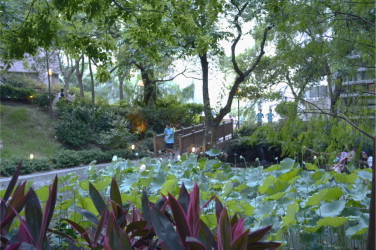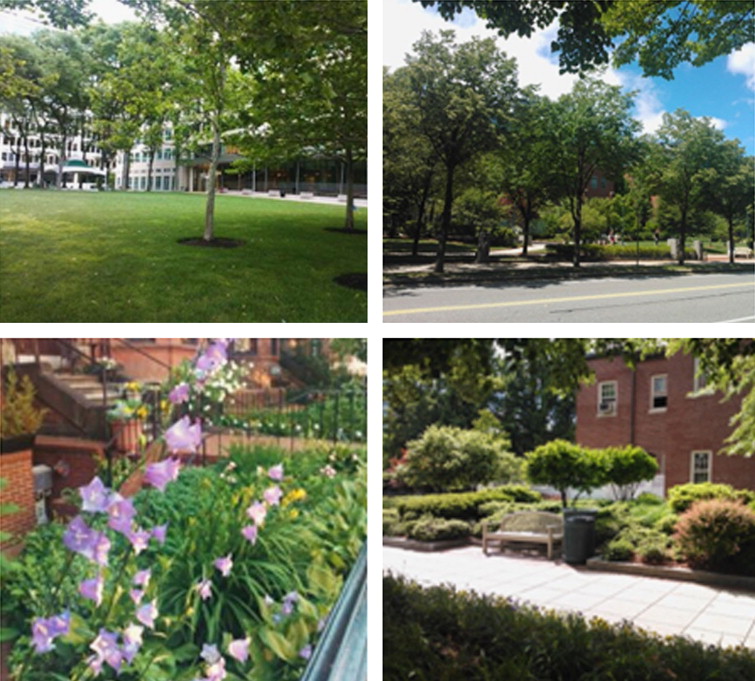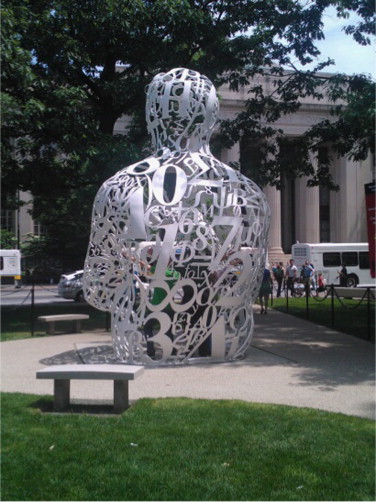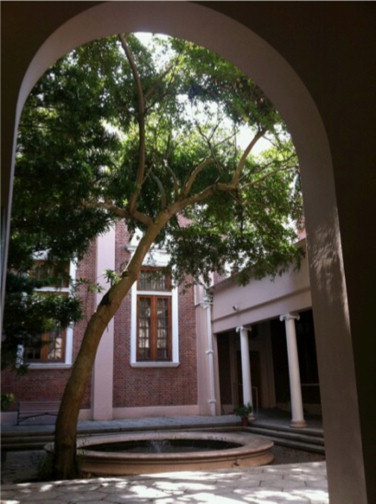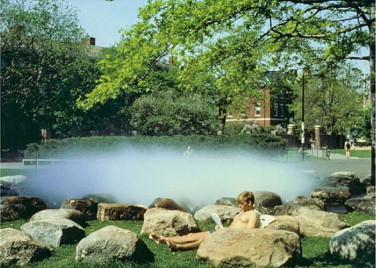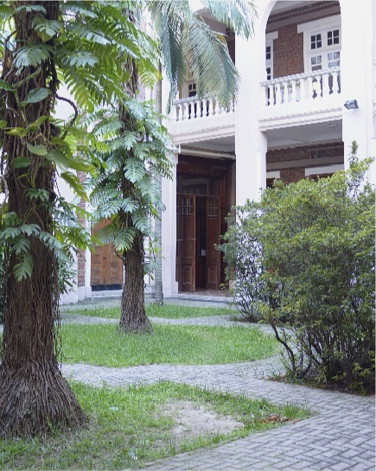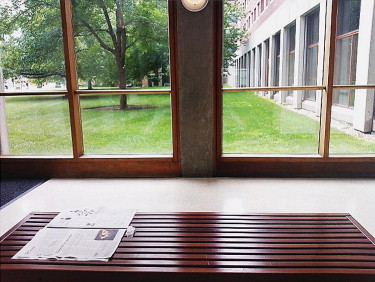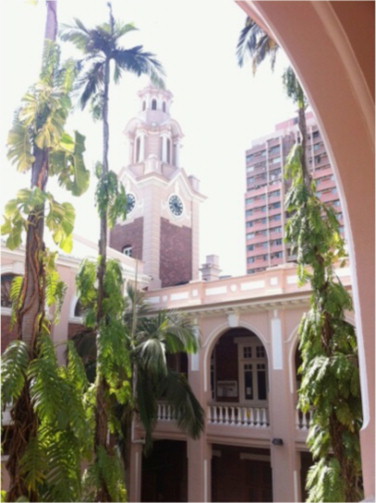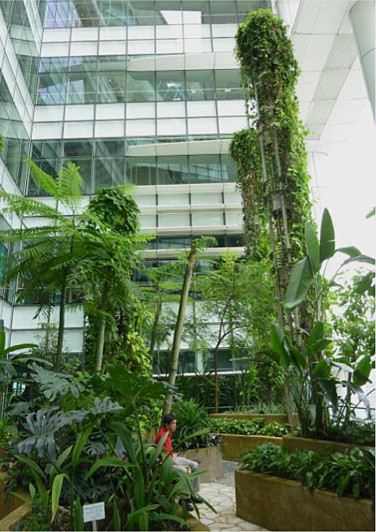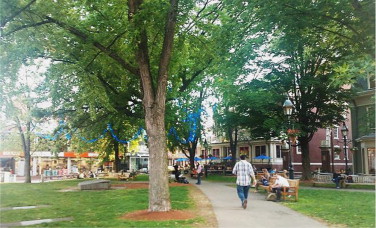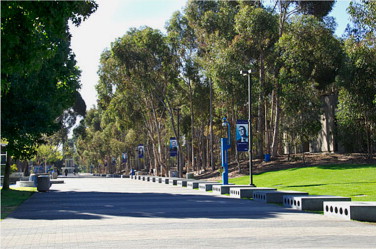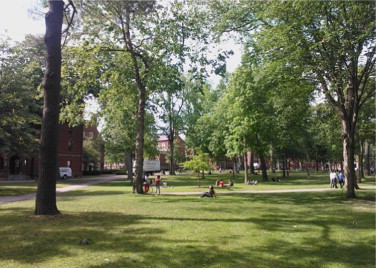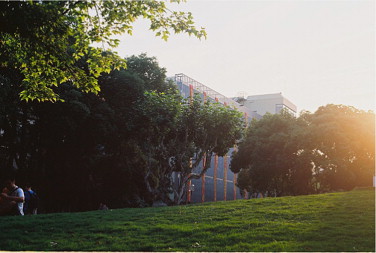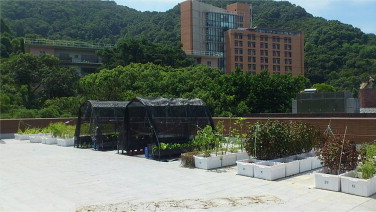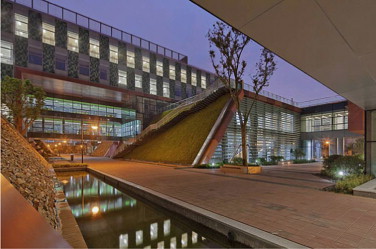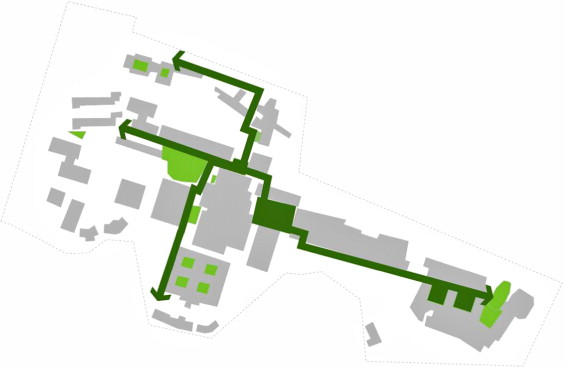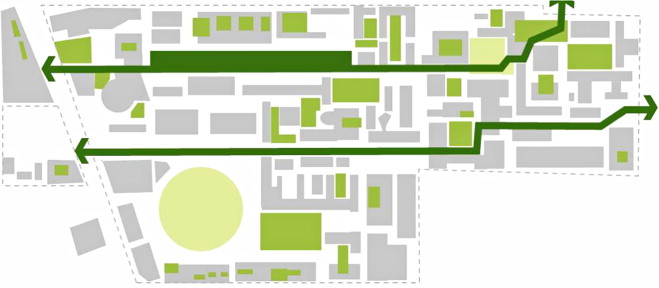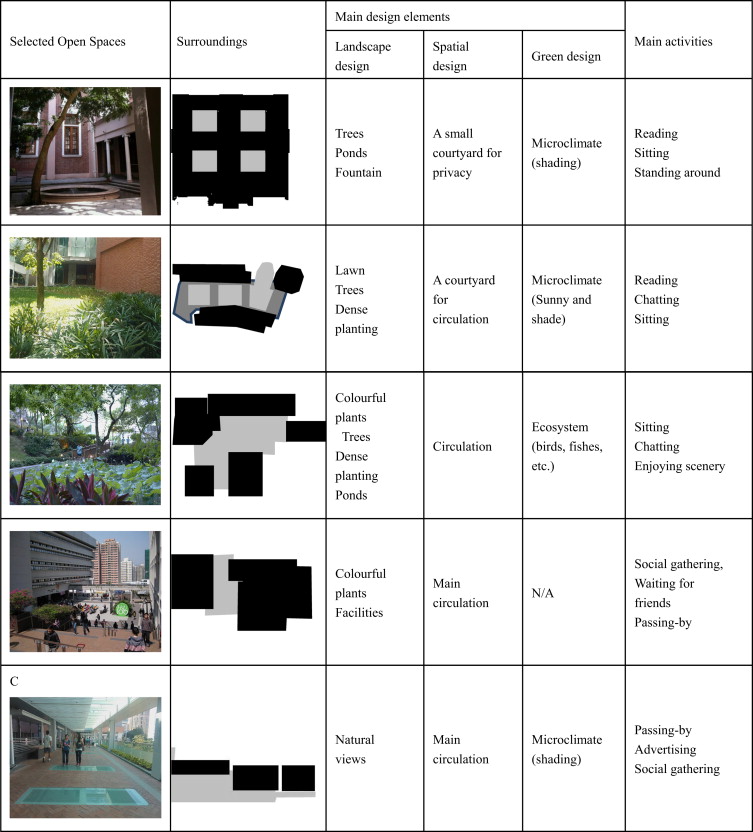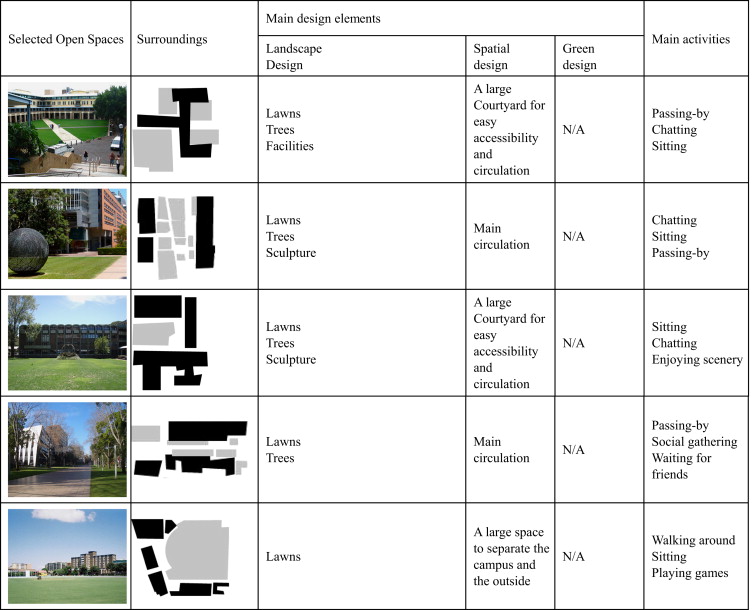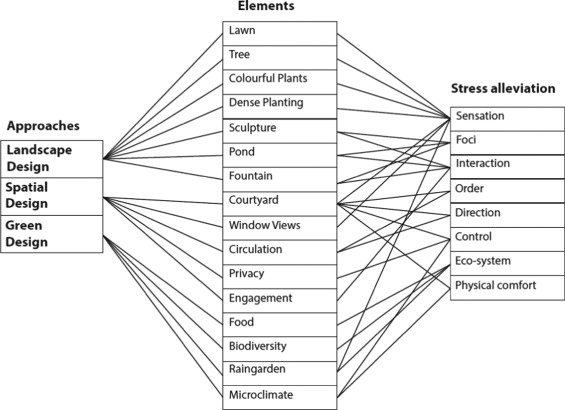Abstract
This paper examines the architectural and landscape design strategies and intentions for green, open spaces facilities targeting stress alleviation for learning environments such as those of university campuses in a compact urban setting. Literature reviews provide three prevailing perspectives for physical design pedagogical operatives: healing gardens where greenery and plants produce restorative effects; flexible spaces that accommodate functional needs of different activities; and green buildings that incorporate open space as a catalyst for integrated eco-system. Corresponding design approaches (landscape design, spatial design and green design) are scrutinized by case study. A comparison of two university campuses with different urban contexts is conducted to identify challenges and opportunities for applying these design approaches. For a compact campus, high-dense surroundings may limit the size of an open space and may handicap circulation and accessibility; on the other side, a small open space may provide its users more intimate contact with natural restorative elements and also a more controllable microclimate for physical comfort. A healthy campus should encompass diverse open spaces to satisfy different purposes. Finally, a framework that integrates the three approaches is combined to produce a sustainable design rubric.
Keywords
Healthy campus ; Open space ; Healing gardens ; Architecture ; Green building
1. Introduction
Universities act as a power house, gushing forth innovative ideas, creative thinking and tangible effects of social and cultural vitality, by connecting the most intelligent, active researchers with a wide source of new knowledge. However, many students are exposed to high levels of stress in their university life. Surveys repetitively show an increasing number of university students who are experiencing significant stress due to interpersonal conflicts, self-esteem problems, financial constraints, time constraints, frustration and emotional problems (Andersson et al ., 2009 ; Chambel and Curral, 2005 ; Misra and Mckean, 2000 ; Mosley et al ., 1994 ). Stress referring to an imbalance between environmental demands and human response capabilities has been evidently linked with physical ill health (Chida and Hamer, 2008 ; Miller et al ., 2002 ; Sagerstrom and Miller, 2004 ) and deteriorated mental health (Hammen, 2005 ). The stressful university life also threatens students׳ academic performance (Hamaideh, 2011 ). In this sense, design of campus is far beyond providing a place for study. It should also be healing–serving functional as well as mental needs.
Open spaces located between buildings and working as joints of surrounding environments, provide a sense of direction in a campus by integrating and organizing different places and elements; they also can provide an esthetic sense by involving attractive surroundings and creating visual surprises. Many creative and innovative ideas occur in outdoor environments, away from formal classes and discussions. The natural scenery and a relaxing atmosphere in open spaces encourage impromptu meetings and discussions, and provide fresh air for stressed scholars (Payne, 2009 ). On the other hand, a large number of university campuses in the world have taken the lead in a green or sustainable building revolution. In green building assessment tools such as Leadership in Energy and Environmental Design (LEED), open spaces as the sphere for micro-ecology and sustainable environments are believed to lead to a healthy community where plants, natural habitats, pavements, shades and lights jointly create an eco-system and microclimate in addition to supplying comfort and sustenance for users (USGBC, 2009 ).
The dual role for social interaction and environmental enhancement–mutually reinforcing one another, features an open space in healthy campus life. How to design open spaces to alleviate students׳ stress and to promote healthy campus life? To answer this question, this paper conducts a literature review to identify in what way an open space may influence human stress. Based on the review, three design approaches (landscape design, spatial design and green design) are discussed respectively with cases and guidelines. The research method is two-step case study. The first case study is a general examination of open space design in different campuses to identify potential design elements and guidelines; the second case study is focused on two campuses respectively representing two different urban contexts (high-dense and low-dense) to find out challenges and opportunities to apply the design elements and guidelines. Finally, a framework is developed for stressing open spaces in the early stage of campus planning and design.
2. Literature review
2.1. Healing garden
There is an accumulated evidence of the influence of the landscape on people׳s health, from ancient times to the present day (Thompson, 2011 ; Velarde et al ., 2007 ). A range of theories and approaches have been forwarded in order to explain and assess this relationship. One of the research approaches relating to health effects of landscapes is known as “Healing Gardens”. The belief that viewing vegetation, water and other natural elements can ameliorate stress makes the design of hospital gardens becomes a new and significant topic (Adevi and Lieberg, 2012 ; Adevi and Mårtensson, 2013 ; Pasha and Shepley, 2013 ; Sherman et al ., 2005 ; Ulrich, 1984 ). Research explains the healing garden with restorative effects that is the process of renewing physical, psychological and social capabilities diminished in ongoing efforts to meet adaptive demands (Hartig and Staats, 2006 ; Kaplan, 1993 ). The restorative effect points out the potential of landscape elements to function therapeutically, reducing cognitive fatigue and other sources of stress. Direct contact with natural elements as well as views of nature both can provide restoration (Eckerling, 1996 ; Ulrich, 1986 ). Table 1 summarizes some evidence of health effects related to viewing these landscapes in the rich body of environmental studies. The health effects of exposure to visual landscapes were examined with diverse approaches, such as neurosciences (blood pressure and heart rate tests), behaviors (days of recovery), perceptions (self-reported emotions and well-being), etc. The literature reveals that natural landscapes gave a stronger positive health effect compared to urban landscapes, and urban landscapes were found to have a less positive and in some cases negative effect on health (Velarde et al., 2007 ). Although most studies were conducted in healthcare environments, the knowledge can also apply to the context of learning environments. In a campus, open spaces are an important natural landscape for healing effects. Theoretically, open spaces can utilize various garden features, especially natural elements such as green plants, flowers and water, to help foster restoration from stress and provide positive influences on human beings. Surveys also show that most university students chose open spaces with natural settings to ameliorate their moods when they were stressed, upset, depressed, angry or confused (Lau and Yang, 2009 ). Open spaces in a campus can help with stress coping and restoration by its beauty and Serenity, fragment flowers, natural sound from birds and water, and exposure to sunshine and other natural elements.
| References | Healing effects | Measurements | Design elements |
|---|---|---|---|
| Ulrich (1984) | Shorter post-operative hospital stays | Number of days in hospital after surgery | Natural scene; trees |
| Heerwagen (1990) | Restorative benefits for heart rate data and emotional states | Heart rate; self-reports of emotional state | Painting of natural scene; distant mountains, sunset, clustered trees and open grassy areas, path (mystery) |
| Leather et al. (1998) | Less job stress and intention to quit | Self-reports of emotional state | Percentage of the view from window with rural elements |
| Wells (2000) | Higher naturalness score post-move gave better cognitive functioning | Behavioral observation | Amount of nature in window view |
| Kuo et al. (1998) | Lower mental fatigue | Attention-tests; neighborhood social ties-test | Varying levels of nature (trees and grass) surrounding public housing (scale 0–4) |
| Taylor et al. (2002) | Improved self-discipline | Attention-tests | Amount of window view of nature |
| Ottosson and Grahn (2005) | Increased powers of concentration | Attention-tests; blood pressure; heart rate | Garden, with old fruit trees and a variety of flower species |
| Van den Berg et al. (2007) | Higher happiness, lower stress, anger, depression and tension | Attention-tests; emotion-test | Park-like forest area with creek |
| Hartig et al. (2007) | Reduced stress and improved mood | Attention-tests; blood pressure; emotion-test | Natural environment: tree views/nature reserve |
2.2. Architectural stimulation
Environmental psychology research has identified that architecture can affect human health through stimulation (Evans and Mccoy, 1998 ). Architectural stimulation describes the amount of information in a space that impinges upon users. Human beings function optimally with moderate levels of stimulation. Lack of stimulation, insufficient stimulation and too much stimulation can cause sensory of deprivation or distraction. For moderate or appropriate stimulation, layout, circulation, control, flexibility, responsiveness, privacy, spatial syntax, defensible space and certain symbolic elements are key architectural factors (Evans and Mccoy, 1998 ; Garling et al ., 1986 ; Stokols, 1992 ). Insufficient spatial resources, inflexible spatial arrangements, and lack of climatic controls, all threaten individual needs to effectively interact with the space. It has been widely accepted that an open and informal atmosphere can stimulate creative expression. However, the stimulation brought by an open space must be moderate. The space must be flexible to embrace individual needs and social interactions. It must also provide control or shelter from discomfort and overstimulation. In the campus life, a well-designed open space shall create an integral blend of private space for concentrated study and public space for collaborative exchanges. Stress also occurs when changes or disruptions in physical surroundings make prediction difficult. Open spaces, therefore, must be coherent. Coherence refers to the clarity or comprehensibility. Ambiguity, disorder, and disorientation are major impediments to coherence.
2.3. Green building and ecosystems
Green building revolution is sweeping the world with its holistic comprehension of sustainability for built environments (Gou et al., 2013 ). Open space is featured in a green building design as a micro eco-system in that it can provide habitat for vegetation and wildlife, create a microclimate for users, and increase stormwater infiltration for soil and land (Hamin and Gurran, 2009 ). In LEED, “Sustainable Site” related credits covering restoring habitats, maximizing open space, stormwater design, heat island mitigation, and biodiversity are proposed to design ecological and sustainable open spaces (USGBC, 2009 ). Many frameworks are being explored to link human and ecosystem health (Tzoulas et al., 2007 ). An integrative framework covers various environmental (e.g., clean air and water, and protection from infections), social (e.g., education, and recreation) and economic (e.g., working and transport) factors affecting health (Macintyre et al., 2002 ). A comprehensive model of livability and quality of life illustrates the complex interplay of factors affecting quality of life including personal, social, cultural, community, natural and built environment, as well as economic factors amongst others (van Kamp et al., 2003 ). These frameworks encourage us to look at the role of built environment design in a broad sense of sustainability. For a campus project, incorporating a sustainable open space can facilitate a highly effective resource for teaching about natural systems, biodiversity, and other ecological and natural science subjects (USGBC, 2010 ). These design strategies are synergistic. For example, when designing a vegetated space to help mitigate urban heat island, a landscape architect can help select native, adapted, and noninvasive species; for biodiversity, the landscape architect should also research the bird species that are likely to use the space and select plants that will provide food, forage, or nesting areas. The idea from green building that designing open spaces from a bio-ecology perspective has a far-reaching implication for healthy campus life.
In sum, there is rich body of evidence showing the potential roles of open spaces in a campus: providing restorative effects for stressed students through natural elements; providing clear direction to reduce spatial ambiguity, disorder and disorientation; and embracing sustainable features to create an ecosystem. However, the literature of the relationships between health and landscapes did not identify specific landscape attributes that enable future architecture and landscape design to be of benefit to human health. To further identify opportunities and potential design attributes, the following sections examine the three perspectives by case studies.
3. Landscape design
3.1. Sensation
Restorative design elements include retreat, fascination, and exposure to nature. Certain types of settings such as religious sanctuaries, hospitals and other therapeutic facilities are explicitly designed with restorative intent. Such settings may uplift the human spirit and promote healing. Design may offer opportunities to combat stress by providing rest, recovery, or contemplation. Of all the healthy design strategies that can be used, plants are the most important in bringing nature back. Open spaces with plants allure people outwards with the sense of nature and cure people with the effect of restoration. To attract users׳ visit and stay, plants design of an open space shall be “mystery” encouraging people to discover an environment and “complexity” providing diverse and rich elements. To be mysterious and complex, landscape design shall make full use of sensations.
People perceive their surroundings using the sense of sight, touch, sound and smell. Design with full consideration of these sensations would enrich people׳s experience and awareness of the place. For the sense of sight, a diverse and dynamic composition of color, texture and pattern of plants can improve the visual quality of the garden; a densely planted flower border can even enlarge the size of a garden by enhancing the plants change in design. For the sense of touch, the special texture of plants can draw people to touch them, and waxy leaves and fluffy flowers can encourage direct interaction between people and natural elements. For the sense of sound, soft sounds in an enclosed area would bring in a sense of serenity and can create a natural symphony that brings relief to people. The soft sounds include plants that make sounds with the rhythms of wind and rain, birds and small insects that sing in trees, and a fountain that spouts tiny water columns. For the sense of smell, the scent of plants, varying from acrid to sweet, from fruity to musky, may delight users of the space. When getting close to the plants, users are enchanted by the magic fragrance from flowers and grass, unconsciously approaching enjoyment.
The Lily Pond in HKU is a typical sensitive garden (Figure 1 ). The richness of the plants in the small garden creates a complex field which attracts people to stay and encourages people to explore. Colorful flowers blossom in different seasons and impress people with seasonal change. The scent from plants, flowers and water embraces people. The delicate songs of birds and swaying of leaves pull people out of their tedious work and returns them to a relaxed ambience.
|
|
|
Figure 1. The Lily Pond as a sensitive garden, HKU. |
To provide a sensory interest to relieve pressure, lawns, trees, colorful plants and dense plantations are the oft-adopted strategies (Figure 2 ).
|
|
|
Figure 2. Lawns (upper left), trees (upper right), colorful plants (lower left) and dense plantations (lower right), MIT. |
3.1.1. Lawns
If possible, a lawn area should be maintained or grown. The sight of lush green is largely welcomed by people. Lawn areas provide a large amount of green and create a playing surface for users of all ages. In addition, the fresh fragrance from newly mown or watered grass is quite charming.
3.1.2. Trees
Trees that are already large or will be large at maturity should be planted. People respond positively to large trees. The striking appearance of trees can easily become the leading attraction of a site and the shade from large canopies is the most welcomed feature outdoor. They are natural habitats for birds and other small animals. Trees are the dispensable elements in most of the spiritual symbolic gardens in campus. Different from the venerable bush living at most several years, trees represent an “external” growth. Their strong trunks and large canopy reflect a sense of stability and dependability.
3.1.3. Colorful plants
Implementing color variation in planting, especially flowers, is another approach to attract people. People enjoy viewing and being in the presence of color and flowers. Research has found that scenery with flowers is very effective in emotion mitigation and reducing feelings of “discourage”. While in existing situation, color is always mentioned as lacking in planting. It has once been said the following about flowers: “you can seldom have enough flowers”.
3.1.4. Dense planting
An area can be densely planted with a variety of trees, shrubs and flowers. A densely planted area provides much more visual interest than a sparsely or mono-planted one. Plants are a source of beauty, shade and color. Without these diverse plants, the area would always be regarded as boring and bare.
Open spaces are to make a place of art, order and quality. But the vague definition of open spaces leads to nowhere. To achieve a vibrant and sustained place, open space design in the campus should be enlightened by the essential aspects of landscape character, which can be understood as a physical expression of five elements: nice; natural scenery; engagement and connections with surroundings; relaxing atmosphere; impromptus encounters and other spontaneous activities; harmonious.
3.2. Function
Many universities, especially in Asia, are built with dense structures, where an open space attracting too many users may impose extra physical and mental stress. How to balance foci and interactions is a salient challenge for open space design.
3.2.1. Foci
Foci in space mark a place of cultural significance. It is usually in the form of a landmark but not limited to it. Foci can visually dominate and make a place distinct from its context in addition to helping people navigate. It is an attraction that draws eyes and movement towards it. It can be designated for recreational activities, a gathering spot or destiny (Figure 3 ). The tiny pond (Figure 4 ) is a focus in Main Building courtyard for most visitors. This yard is regarded as one of the most romantic spots in HKU. Upon approaching the yard, people will be captivated by a tiny fountain located in the center of the yard. The graceful water arcs of the fountain spout and the ripples of the water echo in this enclosed yard, creating feelings of serenity and peace.
|
|
|
Figure 3. A sculpture as foci in MIT. |
|
|
|
Figure 4. A tiny pond as foci in Main Building, HKU. |
3.2.2. Interaction
Open spaces create an area for both planned and spontaneous activities in a natural setting. Landscape elements in open spaces that provide interactions with users would encourage users׳ engagement with open spaces. For users who would like to clear their minds from daily work and seek relaxation, an element which can arouse their interests would alleviate their tense nerves. The Tanner Fountain at the Harvard University elegantly displays an interactive setting (Figure 5 ). Located at a pedestrian crossroad, it openly invites human participation. Evenly scattered boulders suggest no particular activity, while the free setting and the spontaneous dematerializing mist, which creates a fog around the fountain, and inspire a heavy use of people, “who sit, read, climb, jump, flirt, converse and meditate”.
|
|
|
Figure 5. Tanner Fountain, Harvard University. |
Other than the interaction with solid components, another vivid contact is with live animals and plants. The Lily Pond in HKU provides a flourishing habitat for fauna and flora (Figure 6 ). It is home to carps and turtles. In spare time, many people enjoy walking through the small garden to feel the beauty of nature and occasionally observer interact with the animals – the fish leap and play while the turtles bask openly in the pond. Animals find their urban refuge in campus, which in return, animates the campus with full vitality. The pond, with its surrounding plants and species, has established a self-sustained ecosystem.
|
|
|
Figure 6. The Lily Pond for a flourishing habitat, HKU. |
4. Spatial design
4.1. Courtyard
A courtyard that is a form of open space surrounded by buildings can produce natural stimulation via offering scenery and views for surrounding buildings. Window views can effectively facilitate restoration for indoor users. Moreover, visual connection with open spaces would lead to active use of open spaces. Many building users may be lured outside by the awareness of an open space and visit it spontaneously. Visual accessibility to greenery along one׳s path will increase the usage of those areas.
Easy accessibility of a courtyard is crucial to users. If a space is intended for general use, it should be easily found and reached from main public corridors. The central courtyards in Main Building (Figure 7 ) at the University of Hong Kong (HKU) provide spaces for users׳ relaxation and interaction. The courtyards in Main Building are surrounded by a circle of colonnades, which are essential places that students and teachers go through on their way to class. Everyone will pass by these courtyards. When in a hurry, they can walk across the courtyards in a diagonal path to save time. This direct contact with the courtyards increases the use of the courtyards and creates interactions with the space.
|
|
|
Figure 7. A courtyard in Main Building, HKU. |
The void yard is a link between vertically separated floors. Resources from previous discussions reveal that views towards nature and greenery will have significant psychological benefits and fill potential goals of a healing garden (Figure 8 ).
|
|
|
Figure 8. View towards courtyard in Student Amenities Building, MIT. |
In order to spread green and the therapeutic function of the garden, the design could have made the greenery in the courtyard visible. Many small yards confined in between high buildings achieve this by adding vertical greenery, which is related to divergent contexts in soil depth and load bearing, thus resorts to various approaches. Courtyards in the HKU Main Building have a thin soil layer, thus shallow rooted plants are selected, such as shrubs and palms. The bared trunks of the palms are entwined by lush vines, which create the image of vibrant lofty green pillars (Figure 9 ). Similarly, in the National Library of Singapore, the sky-courtyard loaded wind-resistant structures and vibrant vines for erected greenery (Figure 10 ). Likewise, the lush and vivacious vertical greening hanging on the building façade in the School of Art brings nature back into the cold steel and concrete structure.
|
|
|
Figure 9. Another courtyard in Main Building, HKU. |
|
|
|
Figure 10. The sky-courtyard in National Library of Singapore. |
4.2. Circulation
An open space connects different areas of a campus by an axial street, which may form a strong spatial structure in a campus. However, circulation space provides far more than transportation. Well planned circulation can control overstimulation through minimizing exposure to noisiness and congestion. A long distance of similar topology could be tedious. Different functions implanted along the path would avoid monotony and boringness. A vibrant circulation line design should consider path form, variety and sequence (Figure 11 ).
|
|
|
Figure 11. A vibrant street at Harvard University. |
A sequence of open spaces can connect a variety of places and integrate these areas into a holistic system, which create a sense of order and direction. The axial design makes circulation quick and easy and also connects different parts of a campus together. Northwestern University emphasizes the linkage from the northern edge of the campus, to the southern edge, which creates a sequence of wide public open space (Figure 12 ). Circulation space organizes space with surrounding buildings. Shade is recommended along the corridor, with tree canopies or shields which create a covered top along continuous and smooth walkways. The Library Walk at the University of California, San Diego is a broad show stage with plenty of potential for diverse activities (Figure 13 ). The walk is composed of a monumental scale street with paving patterns, seats, platforms for public speaking and intimate scale features, such as adjacent spaces for meeting and relaxing. Walking along this broad street, users will be led to nearby groves. This scenery links the natural with the formal elements and demonstrates the strong sense of pedestrian organization in the campus. Several sections of resting areas are hanging along the street with plant buffers and seats, which transit the transportation space to static areas and enrich the scenery along the path.
|
|
|
Figure 12. A series of open spaces to link different parts of the campus, Northwestern University. |
|
|
|
Figure 13. Library Walk at the University of California, San Diego. |
4.3. Privacy
Reflective activities in particular demand a minimum of distraction and some degree of isolation. Privacy nooks and stimulus shelters may offset some of the stressful impacts of high levels of stimulation. Having a space to retreat to, for example, appears to buffer some of the negative impacts of residential crowding and noise. Focused or voluntary attention can create mental fatigue. Restoration entails the replenishment of cognitive capacity and is fostered by several types of design characteristics. Involuntary attention or fascination facilitates recovery from mental fatigue.
A variety of users may require different spaces. Some prefer privacy, while others prefer openness. A small group discussion may specify an enclosed setting for private talking. For those who prefer passive activities, such as sitting, enjoying scenery or watching others, a natural and open space is preferable. During special occasions, a large space is needed for large group gatherings. An open space also provides space for outdoor leisure activities. Sitting and reading in the same posture for a long time can be damaging to one׳s health and sight. Open spaces can liberate people from the stresses of daily life and encourage people to engage in a wide range of exercise. The newly built centennial campus at the University of Hong Kong designed courtyards in response to the symbolic Main Building, which is famous for its intimate courtyard design. But whether the sense of the courtyards in Main Building has been inherited by the ones in new campus requires discussion. The “Harvard Yard” (Figure 14 ) at Harvard University is regarded as the most identifiable place and a symbolic heart of the school. It represents a typical canopied lawn, which keeps the bustle out by creating a pure and peaceful ambience. It is an amazing transition from a busy, active square to a tranquil pastoral area. Trees in the yard soften the boundary between the courtyard and nearby buildings, which creates a countryside-like ambience. Walking through the campus, subtle overlaps and transitions impress visitors with a rich spatial quality and a fully ease.
|
|
|
Figure 14. Harvard Yard at Harvard University. |
As a lively area assembles a wide range of people, a campus caters to various activities. Having multiple choices in open space would fit users׳ diverse expectations and encourage spontaneous activities. There are two major types of open spaces: one that encourage openness and one that preserve privacy. In a campus setting, openness in space is necessary. A large open space can be used as a gathering place, show-stage or open market during special occasions. For normal uses, large open space can benefit people who like to study or sit in an open space with a broad view. On the other hand, private space better serves individual use, offers more safety and provides isolated space. Private space is usually designed with the prospect and refuge theory, in which landscape is considered pleasurable with prospect while providing refuge. The sense of privacy can be realized by adding small enclosure of pergola caters or by canopies of trees. One of the open space models combining openness and privacy is an area with an open lawn or square in the center as public space but also an intimate, private space with canopies or plant buffers at the edge. Plants are essential in creating privacy. Seats under trees or pergolas are the most welcoming space for individual use, in which canopies define the space and plants block direct sight from the surrounding areas. These spaces fit users who like to study or relax in an isolated area without disturbance and attention.
Since people have different ideas of comfort, various choices of sunny and shaded spaces should be offered. During different seasons, people׳s preferences towards sunny and shaded areas change. In winter, spring and autumn, most people prefer a sunbathe space. In summer, shaded areas become more preferable because they protect people from getting burnt by the sun. Whether open space needs sunshine or not depends very much on individual tastes. Some may love being exposed to sunshine during reading and chatting, while others may prefer being in a shaded area. Thus, a diverse choice of spaces that provide sunshine and shade should be implemented on campus. The Valentines Slope at Tongji University is always fully occupied during times of good weather, particularly spring and autumn (Figure 15 ). The southern facing slope with a golden gradient captures warmth from sunshine and preferences from users. During hot times, shade is necessary for those staying outdoors. It helps avoid direct sunshine and also creates a tranquil venue.
|
|
|
Figure 15. Valentines Slope at Tongji University. |
5. Green design
An open space can be perceived as an ecosystem, which offers habitats, sustains creatures, harvest rainwater and forms its own microclimate. Covered by greenery, open space provides an urban “natural refuge” for insects, small animals and people. It is an important habitat for native plants and animals and helps preserve local biodiversity. It is essential to maximize resilience and dynamic stability in landscape for creating a stable ecological community. The complex interaction between elements creates a diverse relationship and requires a variety of elements.
5.1. Eco-system
The purpose of creating an ecosystem within the built environment is to allow it to work as a natural support system that supplies a life cycle without depleting environmental resources. A green roof or open space on the site can provide space for growing food, which can be used to teach students about food sources, agricultural practices, and nutrition. A self-sufficient garden can minimize the negative impact to the surrounding environment but also improve the local ecosystem by increasing carbon dioxide–oxygen exchange and the diversity of plants and animals. Landscaping elements are the basic components of this structure. Design should respect the site and be in harmony with the site׳s ecological potential. The “Rooftop Farming Project” at University of Hong Kong (Figure 16 ) is a showcase of self-sufficient campus project that makes full use of rooftop open spaces in a compact campus to produce foods. The project is to raise the awareness of healthy campus life and foster a sense of responsibility to the natural environment by reconnecting people and farming. It also aims to explore the potential value of rooftops in a high-density urban campus. By working closely with the vegetarian restaurant on campus, this project demonstrates how one may put in real practice a sustainable food cycle that encourages consumption of local produce with minimal carbon footprints and reduces food waste by composting. Compost from standard composting bins and vermin culture (worm composting) can provide opportunities to learn about plant ecosystems, biology, and nutrient cycles and also be used in school vegetable gardens.
|
|
|
Figure 16. Rooftop Farming Project, HKU. |
5.2. Water garden
Water or rain garden is a kind of open space that helps with storm-water management. Deep-rooted native plants and grasses are planted, which capture rainwater runoff and stop water from reaching the sewer system. Rainwater soaks through the permeable surface of soil and supplements the groundwater. This natural purification system improves the water quality of ground water. Water gardens can be used for explorations of natural habitats in aquatic ecology studies–without needing a bus for field trips. Rain collection and distribution systems can be used to teach students about the water cycle. Constructed wetlands can filter wastewater from the building while teaching students about the biological processes, habitats, and importance of these ecosystems in nature. Inspired by the famous water gardens in Chinese Gardens of Suzhou, the Xi׳An Jiaotong Liverpool University Suzhou Campus adopts a dynamic strategy of horizontal and vertical layering to create a series of interwoven spaces for rainwater harvesting (Figure 17 ).
|
|
|
Figure 17. Water gardens at Xi׳an Jiaotong-Liverpool University, Suzhou Campus. |
5.3. Microclimate
Temperature and light are two key elements for a microclimate. Natural lighting minimizes the need for artificial lighting in buildings and reduces electrical lighting loads, which can assist with cooling the temperature of buildings because electrical lighting releases heat as a by-product. Natural lighting can also improve productivity and health in schools while lower schools׳ maintenance costs. Natural lighting can potentially increase the operation efficiency of both buildings and their occupants. Natural ventilation imports external air to benefit the occupants of buildings. However, allowing fresh air into a building does have a minor drawback – it may result in a building׳s interior environment becoming dustier or noisier. Compact campuses are crowded with buildings, which can increase the surrounding air temperature – essentially creating an “urban heat island”. Two principles – shading solid surface in open space and maintaining the wind breeze – are the main approach to overcome the urban heat island. These two strategies can be achieved by providing open spaces with greenery coverage. Open to the sky allows light to pour into the surrounding rooms without bringing in glare. Spaces around the courtyard stay well-lit during the daytime without artificial lighting. It is crucial to maintain the right height-to-width proportion in courtyard. A courtyard with a height that is the same or taller up to three times its width is perceived to be efficient to provide shading in the yard. A courtyard that is too tall may drop its scale and lose its control on lighting and air. A courtyard that is too shallow does not play climatic efficiently because it exposes too much directly under sunshine during hot weather. This theory has been proven by courtyards in the Main Building, whose width/height ratio is greater than 1. The courtyard in Main Building has consequently been recognized as an exemplar of a comfortable sense of space (Lau and Yang, 2009 ).
6. Assessment
The general case studies on different campuses can provide many good examples. However, they may not consider specific campus conditions and open space accessibility. This section conducts an assessment of abovementioned design elements in two university campuses with different urban contexts. The first case is the main campus of University of Hong Kong (HKU) which is located in a compact urban context with a restricted footprint. The HKU main campus covers 160,000 m2 of land on Bonham Road and Pokfulam Road in the Mid-Levels of Hong Kong Island in Hong Kong. It is a high-dense campus with 34 buildings. The second case is the main campus of University of New South Wales (UNSW) which is located in a low dense and suburb context. The UNSW main campus is located on a 380,000 m2 site at Kensington, an eastern suburb of Sydney, Australia. It has 44 buildings. They both are pedestrian friendly campuses. Figure 18 ; Figure 19 respectively show open space distributions in the two campuses. Compared to the UNSW main campus, the HKU main campus has very tight open space. Open spaces distribute averagely in the UNSW campus to guide the flow of pedestrian; while open spaces in the HKU campus are separated by buildings and some of them are not easily accessed. The tight land use condition posits a big challenge for compact campuses: how can open spaces play the healing role in a restricted context?
|
|
|
Figure 18. Open space distributions in the main campus of HKU. |
|
|
|
Figure 19. Open space distributions in the main campus of UNSW. |
Table 2 ; Table 3 further examine each of design elements mentioned above. Observations were conducted during peak hours (lunch time) of weekdays to continuously record and categorize students׳ activities. Generally, outdoor activities in public spaces can be divided into three categories: transitional activities (waiting for a person, passing-by, etc.); personal activities (reading, taking a walk to get a breath of fresh air, standing around enjoying life, or sitting and sunbathing) and social activities (playing games, meeting others and conversation, communal activities of various kinds, etc.) (Shi et al., 2014 ). Top three activities are identified for each space. Obviously, the UNSW campus provides more spacious open spaces with lawns to accommodate transitional and social activities; while the HKU campus accommodates more sensational elements in its small open spaces. Generally, when an open space is easily accessed (e.g. close to the main circulation of the campus), it is likely to be a place for circulation and social interaction; when an open space is less easily accessed, it is likely to be a place for personal activities. An open space in the UNSW campus tends to have a distant relationship with its surrounding buildings while an open space tends to have an intimate relationship with its surroundings in the HKU campus. Although a large open space with a distant relationship with its surroundings is of benefit for sense of orientation and order, it is hard to control microclimate conditions especially in extreme weather and it is also hard to provide its users intimate contact with sensational natural elements. A healthy environment should provide people with intimate relations to restorative natural environments using small open spaces and also provide people with socially supportive and easily accessed outdoor environments using large scale open spaces. Therefore, a healthy campus must encompass diverse open spaces for different purposes.
|
|
|
Table 2. Assessment for open spaces in the Main Campus of University of Hong Kong. |
|
|
|
Table 3. Assessment for open spaces in the Main Campus of University of New South Wales. |
7. Conclusion
The essential concept of healthy design, which is used originally in hospitals to accelerate patients׳ recovery, has been applied to open spaces design, in which natural features assist users in relaxing and restoring their minds from stress. Combined with ideas to healing gardens, architectural stimulation, and green building approaches, this paper studies exemplary cases of contemporary campus design with an aim to provide campus open space design guidelines. The guidelines could be incorporated into landscape design, spatial design and green design practice. Landscape design is looking at creating natural environments and sensational connections for restoration; spatial design is looking at arranging easily accessed spaces to provide good sense of orientation and order for different activities; and green design is looking at building an eco-system inclusive of sustainability features as well as physical comfort. A comprehensive combination of these design strategies will realize the restorative effect of an open space and lead to a wide range of comfort for users – from physical enjoyment to emotional relief – that further promotes well-being in campus (Figure 20 ). Comparison of two campuses found that these design elements and guidelines are subject to the land use and urban context of a campus. For a compact campus, high-dense surroundings may limit the space for larger lawns and wider views that may handicap easy accessibility and circulation. On the other hand, small open spaces with sensational landscapes may be more intimate to users for the health effects. The campus should encompass open spaces in diverse scales to satisfy different purposes.
|
|
|
Figure 20. Framework for healthy campus open space design. |
The design guidelines and case studies modify the qualitative evaluation of people׳s well-being to a quantitative estimation through methods of landscape design, spatial design and green design. The next step of research should further quantitatively examine the collection of design strategies to achieve optimum use of space and create a healthy, vibrant and sustainable learning, teaching and research environment.
Acknowledgements
The authors would like to acknowledge the sponsorship for field trips by the China Green Building Council Hong Kong Chapter.
References
- Adevi and Lieberg, 2012 Anna A. Adevi, Mats Lieberg; Stress rehabilitation through garden therapy: a caregiver perspective on factors considered most essential to the recovery process; Urban For. Urban Green., 11 (1) (2012), pp. 51–58 http://dx.doi.org/10.1016/j.ufug.2011.09.007
- Adevi and Mårtensson, 2013 Anna A. Adevi, Fredrika Mårtensson; Stress rehabilitation through garden therapy: the garden as a place in the recovery from stress; Urban For. Urban Green., 12 (2) (2013), pp. 230–237 http://dx.doi.org/10.1016/j.ufug.2013.01.007
- Andersson et al., 2009 C. Andersson, K.O. Johnsson, M. Burgland, A. Ojehgen; Stress and hazardous alcohol use: associations with early dropout from university; Scand. J. Public Health, 37 (2009), pp. 713–719
- Chambel and Curral, 2005 M.J. Chambel, L. Curral; Stress in academic life: work characteristics as predictors of student well-being and performance; Appl. Psychol.: Int. Rev., 54 (2005), pp. 135–147
- Chida and Hamer, 2008 Y. Chida, M. Hamer; Chronic psychological factors and cute physiological responses to laboratory-induced stress in healthy populations: a quantitative review of 30 years of investigations; Psychol. Bull., 134 (2008), pp. 829–885
- Eckerling, 1996 M. Eckerling; Guidelines for designing healing gardens; J. Ther. Hortic., 8 (1996), pp. 21–25
- Evans and Mccoy, 1998 G.W. Evans, J.M. Mccoy; When buildings don׳t work: the role of architecture in human health; J. Environ. Psychol., 18 (1998), pp. 85–94
- Garling et al., 1986 T. Garling, A. Book, E. Lindberg; Spatial orientation and wayfinding in the designed environment: a conceptual analysis and some suggestions for post-occupancy evaluation; J. Archit. Plan. Res., 3 (1986), pp. 55–64
- Gou et al., 2013 Zhonghua Gou, Prasad, Deo, Stephen Siu-Yu Lau; Are green buildings more satisfactory and comfortable?; Habitat Int., 39 (0) (2013), pp. 156–161 http://dx.doi.org/10.1016/j.habitatint.2012.12.007
- Hamaideh, 2011 S.H. Hamaideh; Stressors and reactions to stressors among university students; Int. J. Soc. Psychiatry, 57 (1) (2011), pp. 69–80
- Hamin et al., 2009 Elisabeth M. Hamin, Gurran, Nicole; Urban form and climate change: balancing adaptation and mitigation in the U.S. and Australia; Habitat Int., 33 (3) (2009), pp. 238–245 http://dx.doi.org/10.1016/j.habitatint.2008.10.005
- Hammen, 2005 C. Hammen; Stress and depression; Annu. Rev. Clin. Psychol., 1 (2005), pp. 293–319
- Hartig et al., 2007 T. Hartig, T. Bringslimark, G.G. Patil; Restorative environmental design: what, when, where and for whom; S. Kellert, J. Heerwagen, M. Mador (Eds.), Bringing Buildings to Life: The Theory and Practice of Biophilic Building Design, Wiley, New York, NY (2007)
- Hartig and Staats, 2006 T. Hartig, H. Staats; The need for psychological restoration as a determinant of environmental preferences; J. Environ. Psychol., 26 (2006), pp. 215–226
- Heerwagen, 1990 Heerwagen, J., 1990. The psychological aspects of windows and window design. In: Paper Presented at the Proceedings of the 21st Annual Conference of the Environmental Design Research Association. Oklahoma City.
- Kaplan, 1993 R. Kaplan; The role of nature in the context of the workplace; Landsc. Urban Plan., 26 (1993), pp. 193–201
- Kuo et al., 1998 F.E. Kuo, W.C. Sullivan, R.L. Coley, L. Brunson; Fertile ground for community: inner-city neighbourhood common spaces; Am. J. Community Psychol., 26 (1998), pp. 823–851
- Lau and Yang, 2009 Stephen S.Y. Lau, Feng Yang; Introducing healing gardens into a compact university campus: design natural space to create healthy and sustainable campuses; Landsc. Res., 34 (1) (2009), pp. 55–81 http://dx.doi.org/10.1080/01426390801981720
- Leather et al., 1998 P. Leather, M. Pyrgas, D. Beale, C. Lawrence; Windows in the workplace; Environ. Behav., 30 (1998), pp. 739–762
- Macintyre et al., 2002 Sally Macintyre, Anne Ellaway, Steven Cummins; Place effects on health: how can we conceptualise, operationalise and measure them?; Soc. Sci. Med., 55 (1) (2002), pp. 125–139 http://dx.doi.org/10.1016/S0277-9536(01)00214-3
- Miller et al., 2002 G.E. Miller, S. Cohen, A.K. Ritchey; Chronic psychological stress and regulation of pro-inflammatory cytokines: a glucocorticoid-resistance model; Health Psychol., 21 (2002), pp. 531–541
- Misra and Mckean, 2000 R. Misra, M. Mckean; College students׳ academic stress and its relation to their anxiety, time management, and leisure satisfaction; Am. J. Health Stud., 16 (2000), pp. 41–52
- Mosley et al., 1994 T.H. Mosley, S.C. Perrin, S.M. Neral, P.M. Dubbert, C.A. Grothues, B.M. Pinto; Stress, coping, and well-being among third-year medical students; Acad. Med., 69 (1994), pp. 765–767
- Ottosson and Grahn, 2005 J. Ottosson, P. Grahn; A comparison of leisure time spent in a garden with leisure time spent indoors: on measures of restoration in residents in geriatric care; Landsc. Res., 30 (2005), pp. 23–55
- Pasha and Shepley, 2013 Samira Pasha, Mardelle M. Shepley; Research note: physical activity in pediatric healing gardens; Landsc. Urban Plan., 118 (0) (2013), pp. 53–58 http://dx.doi.org/10.1016/j.landurbplan.2013.05.005
- Payne, 2009 Sarah Payne; Open space: people space; J. Environ. Psychol., 29 (4) (2009), pp. 532–533 http://dx.doi.org/10.1016/j.jenvp.2009.10.007
- Sagerstrom and Miller, 2004 S.C. Sagerstrom, G.E. Miller; Psychological stress and the human immune system: a meta-analytic study of 30 years of inquiry; Psychol. Bull., 130 (2004), pp. 601–630
- Sherman et al., 2005 Sandra A. Sherman, James W. Varni, Roger S. Ulrich, Vanessa L. Malcarne; Post-occupancy evaluation of healing gardens in a pediatric cancer center; Landsc. Urban Plan., 73 (2–3) (2005), pp. 167–183 http://dx.doi.org/10.1016/j.landurbplan.2004.11.013
- Shi et al., 2014 Shulin Shi, Zhonghua Gou, Leslie H.C. Chen; How does enclosure influence environmental preferences? A cognitive study on urban public open spaces in Hong Kong; Sustain. Cities Soc., 13 (2014), pp. 148–156 http://dx.doi.org/10.1016/j.scs.2014.04.011
- Stokols, 1992 D. Stokols; Establishing and maintaining healthy environments: towards a social ecology of health promotion; Am. Psycho., 47 (1992), pp. 6–22
- Taylor et al., 2002 A.F. Taylor, F.E. Kuo, W.C. Sullivan; Views of nature and self-discipline: evidence from inner city children; J. Environ. Psychol., 22 (2002), pp. 49–63
- Thompson, 2011 Catharine Ward Thompson; Linking landscape and health: the recurring theme; Landsc. Urban Plan., 99 (2011), pp. 187–195
- Tzoulas et al., 2007 Konstantinos Tzoulas, Kalevi Korpela, Stephen Venn, Vesa Yli-Pelkonen, Aleksandra Kaźmierczak, Jari Niemela, Philip James; Promoting ecosystem and human health in urban areas using Green Infrastructure: a literature review; Landsc. Urban Plan., 81 (3) (2007), pp. 167–178 http://dx.doi.org/10.1016/j.landurbplan.2007.02.001
- Ulrich, 1984 R.S. Ulrich; View through a window may influence recovery from surgery; Science, 224 (4467) (1984), pp. 420–421
- Ulrich, 1986 R.S. Ulrich; Human response to vegetation and landscape; Landsc. Urban Plan., 13 (1986), pp. 29–44
- USGBC, 2009 USGBC, 2009. LEED 2009 for New Construction and Major Renovations. U.S. Green Building Council.
- USGBC, 2010 USGBC, 2010. Green Building and Human Experience: Research Program White Paper. U.S. Green Building Council.
- Van den Berg et al., 2007 A.E. Van den Berg, T. Hartig, H. Staats; Preference for nature in urbanized societies: stress, restoration, and the pursuit of sustainability; J. Soc. Issues, 63 (1) (2007), pp. 79–96
- van Kamp et al., 2003 Irene van Kamp, Kees Leidelmeijer, Marsman, Gooitske, de Hollander, Augustinus; Urban environmental quality and human well-being: towards a conceptual framework and demarcation of concepts; a literature study; Landsc. Urban Plan., 65 (1–2) (2003), pp. 5–18 http://dx.doi.org/10.1016/S0169-2046(02)00232-3
- Velarde et al., 2007 Ma.D. Velarde, G. Fry, M. Tveit; Health effects of viewing landscapes – landscape types in environmental psychology; Urban For. Urban Green., 6 (4) (2007), pp. 199–212 http://dx.doi.org/10.1016/j.ufug.2007.07.001
- Wells, 2000 N.M. Wells; At home with nature: effects of greenness on children׳s cognitive functioning; Environ. Behav., 32 (2000), pp. 775–795
Document information
Published on 12/05/17
Submitted on 12/05/17
Licence: Other
Share this document
Keywords
claim authorship
Are you one of the authors of this document?
